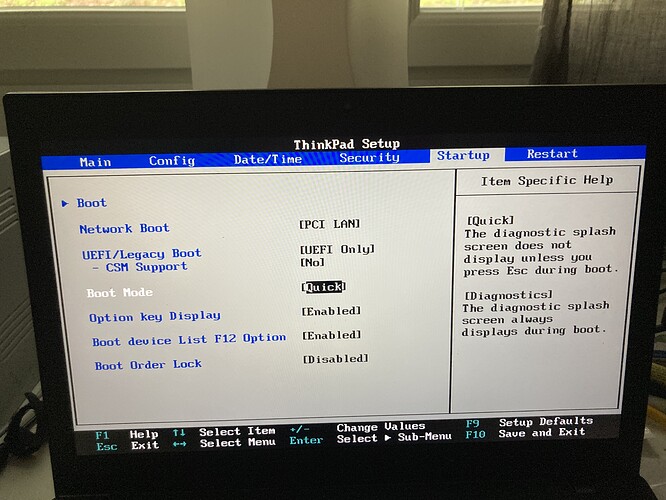Does anybody have a Lenovo Thinkpad T460 laptop? Do you ever get stuck in Lenovo logo for several seconds before grub screen appears? I have at least 12 seconds delay. After that delay the system boots normally. So I guess this has nothing to do with system but more like it’s hardware related? Probably there’s nothing I could do about it, but I would be interested in to know if you have similar experiences with your Thinkpads.
Here’s my inxi -Faz:
mardimus@mardimus-20fms0ty00 ~]$ inxi -Faz
System:
Kernel: 6.9.7-arch1-1 arch: x86_64 bits: 64 compiler: gcc v: 14.1.1
clocksource: tsc avail: hpet,acpi_pm
parameters: BOOT_IMAGE=/boot/vmlinuz-linux
root=UUID=08afffbd-69cb-47a3-b3be-83bd8d4c16f2 rw nowatchdog
nvme_load=YES loglevel=3
Desktop: Xfce v: 4.18.1 tk: Gtk v: 3.24.36 wm: xfwm4 v: 4.18.0
with: plank,xfce4-panel tools: xscreensaver,xscreensaver-systemd vt: 7 dm:
1: LightDM v: 1.32.0 2: SDDM note: stopped Distro: EndeavourOS
base: Arch Linux
Machine:
Type: Laptop System: LENOVO product: 20FMS0TY00 v: ThinkPad T460
serial: <superuser required> Chassis: type: 10 serial: <superuser required>
Mobo: LENOVO model: 20FMS0TY00 serial: <superuser required>
part-nu: LENOVO_MT_20FM_BU_Think_FM_ThinkPad T460 uuid: <superuser required>
UEFI: LENOVO v: R06ET71W (1.45 ) date: 02/21/2022
Battery:
ID-1: BAT0 charge: 8.8 Wh (50.6%) condition: 17.4/23.2 Wh (75.0%)
volts: 11.4 min: 11.1 model: SANYO 45N1773 type: Li-ion serial: <filter>
status: not charging
ID-2: BAT1 charge: 13.2 Wh (78.6%) condition: 16.8/23.5 Wh (71.3%)
volts: 12.2 min: 11.4 model: LGC 45N1127 type: Li-ion serial: <filter>
status: not charging
CPU:
Info: model: Intel Core i5-6300U bits: 64 type: MT MCP arch: Skylake
gen: core 6 level: v3 note: check built: 2015 process: Intel 14nm family: 6
model-id: 0x4E (78) stepping: 3 microcode: 0xF0
Topology: cpus: 1x cores: 2 tpc: 2 threads: 4 smt: enabled cache:
L1: 128 KiB desc: d-2x32 KiB; i-2x32 KiB L2: 512 KiB desc: 2x256 KiB
L3: 3 MiB desc: 1x3 MiB
Speed (MHz): avg: 1667 high: 2970 min/max: 400/3000 scaling:
driver: intel_pstate governor: performance cores: 1: 2970 2: 2900 3: 400
4: 400 bogomips: 20004
Flags: avx avx2 ht lm nx pae sse sse2 sse3 sse4_1 sse4_2 ssse3
Vulnerabilities:
Type: gather_data_sampling status: Vulnerable: No microcode
Type: itlb_multihit status: KVM: VMX unsupported
Type: l1tf mitigation: PTE Inversion
Type: mds mitigation: Clear CPU buffers; SMT vulnerable
Type: meltdown mitigation: PTI
Type: mmio_stale_data mitigation: Clear CPU buffers; SMT vulnerable
Type: reg_file_data_sampling status: Not affected
Type: retbleed mitigation: IBRS
Type: spec_rstack_overflow status: Not affected
Type: spec_store_bypass mitigation: Speculative Store Bypass disabled via
prctl
Type: spectre_v1 mitigation: usercopy/swapgs barriers and __user pointer
sanitization
Type: spectre_v2 mitigation: IBRS; IBPB: conditional; STIBP: conditional;
RSB filling; PBRSB-eIBRS: Not affected; BHI: Not affected
Type: srbds mitigation: Microcode
Type: tsx_async_abort mitigation: TSX disabled
Graphics:
Device-1: Intel Skylake GT2 [HD Graphics 520] vendor: Lenovo driver: i915
v: kernel arch: Gen-9 process: Intel 14n built: 2015-16 ports: active: eDP-1
empty: DP-1, DP-2, HDMI-A-1, HDMI-A-2 bus-ID: 00:02.0 chip-ID: 8086:1916
class-ID: 0300
Device-2: Chicony Integrated Camera driver: uvcvideo type: USB rev: 2.0
speed: 480 Mb/s lanes: 1 mode: 2.0 bus-ID: 1-10:5 chip-ID: 04f2:b52c
class-ID: 0e02 serial: <filter>
Display: x11 server: X.Org v: 21.1.13 compositors: 1: Picom v: git-89c2c
2: xfwm4 v: 4.18.0 driver: X: loaded: modesetting
alternate: fbdev,intel,vesa dri: iris gpu: i915 display-ID: :0.0
screens: 1
Screen-1: 0 s-res: 1920x1080 s-dpi: 96 s-size: 508x285mm (20.00x11.22")
s-diag: 582mm (22.93")
Monitor-1: eDP-1 model: LG Display 0x04f9 built: 2015 res: 1920x1080
hz: 60 dpi: 158 gamma: 1.2 size: 309x174mm (12.17x6.85") diag: 355mm (14")
ratio: 16:9 modes: 1920x1080
API: EGL v: 1.5 hw: drv: intel iris platforms: device: 0 drv: iris
device: 1 drv: swrast surfaceless: drv: iris x11: drv: iris
inactive: gbm,wayland
API: OpenGL v: 4.6 compat-v: 4.5 vendor: intel mesa v: 24.1.2-arch1.1
glx-v: 1.4 direct-render: yes renderer: Mesa Intel HD Graphics 520 (SKL GT2)
device-ID: 8086:1916 memory: 7.56 GiB unified: yes
Audio:
Device-1: Intel Sunrise Point-LP HD Audio vendor: Lenovo
driver: snd_hda_intel v: kernel alternate: snd_soc_skl,snd_soc_avs
bus-ID: 00:1f.3 chip-ID: 8086:9d70 class-ID: 0403
API: ALSA v: k6.9.7-arch1-1 status: kernel-api
tools: alsactl,alsamixer,amixer
Server-1: PipeWire v: 1.2.0 status: active with: 1: pipewire-pulse
status: active 2: wireplumber status: active 3: pipewire-alsa type: plugin
4: pw-jack type: plugin tools: pactl,pw-cat,pw-cli,wpctl
Network:
Device-1: Intel Ethernet I219-LM vendor: Lenovo driver: e1000e v: kernel
port: N/A bus-ID: 00:1f.6 chip-ID: 8086:156f class-ID: 0200
IF: enp0s31f6 state: down mac: <filter>
Device-2: Intel Wireless 8260 driver: iwlwifi v: kernel pcie: gen: 1
speed: 2.5 GT/s lanes: 1 bus-ID: 04:00.0 chip-ID: 8086:24f3 class-ID: 0280
IF: wlan0 state: up mac: <filter>
Info: services: NetworkManager, systemd-timesyncd, wpa_supplicant
Bluetooth:
Device-1: Intel Bluetooth wireless interface driver: btusb v: 0.8 type: USB
rev: 2.0 speed: 12 Mb/s lanes: 1 mode: 1.1 bus-ID: 1-7:3 chip-ID: 8087:0a2b
class-ID: e001
Report: btmgmt ID: hci0 rfk-id: 2 state: down bt-service: disabled
rfk-block: hardware: no software: no address: N/A
Drives:
Local Storage: total: 238.47 GiB used: 10.27 GiB (4.3%)
SMART Message: Unable to run smartctl. Root privileges required.
ID-1: /dev/nvme0n1 maj-min: 259:0 vendor: Toshiba model: N/A
size: 238.47 GiB block-size: physical: 512 B logical: 512 B speed: 15.8 Gb/s
lanes: 2 tech: SSD serial: <filter> fw-rev: 510657LA temp: 29.9 C
scheme: GPT
Partition:
ID-1: / raw-size: 21.48 GiB size: 20.98 GiB (97.65%) used: 8.85 GiB (42.2%)
fs: ext4 dev: /dev/nvme0n1p4 maj-min: 259:4
ID-2: /boot/efi raw-size: 100 MiB size: 96 MiB (96.00%)
used: 40.7 MiB (42.4%) fs: vfat dev: /dev/nvme0n1p1 maj-min: 259:1
ID-3: /home raw-size: 100.68 GiB size: 98.54 GiB (97.87%)
used: 1.38 GiB (1.4%) fs: ext4 dev: /dev/nvme0n1p5 maj-min: 259:5
Swap:
Alert: No swap data was found.
Sensors:
System Temperatures: cpu: 47.0 C pch: 45.0 C mobo: N/A
Fan Speeds (rpm): fan-1: 0
Info:
Memory: total: 16 GiB available: 15.48 GiB used: 2.23 GiB (14.4%)
Processes: 194 Power: uptime: 12m states: freeze,mem,disk suspend: deep
avail: s2idle wakeups: 0 hibernate: platform avail: shutdown, reboot,
suspend, test_resume image: 6.18 GiB services: upowerd,xfce4-power-manager
Init: systemd v: 256 default: graphical tool: systemctl
Packages: pm: pacman pkgs: 987 libs: 284 tools: pamac,yay Compilers:
gcc: 14.1.1 Shell: Bash v: 5.2.26 running-in: xfce4-terminal inxi: 3.3.35


